
Concept explainers
(a)
Interpretation:
The correct IUPAC name of
Concept introduction:
Rules for writing IUPAC name from the structural formula are given below.
• First, identify the longest carbon chain.
• The next step is to identify the groups attached to the longest chain.
• Identify the position, location, and a number of the substituents bonded to the carbon chain.
• Use prefix di, tri, tetra if the same type of substituents are present.
• Name the substituents in alphabetical order.
Answer to Problem 4.46AP
The correct IUPAC name of
Explanation of Solution
When a compound is named the first thing is to identify the longest parent chain. If the parent chain is substituted, then it is numbered in such a manner so that the substituent gets the lowest locant number. In the given case, the structure is written as shown below.
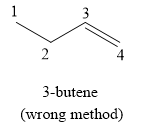
Figure 1
The method of numbering the parent chain is wrong because it is substituted by a double bond. It has to be numbered in such a way so that double bond gets the lowest locant number. The lowest locant number is
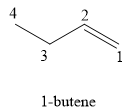
Figure 2
The structure is named as
The correct IUPAC name of
(b)
Interpretation:
The correct IUPAC name of
Concept introduction:
Alkenes are the unsaturated class of organic compounds which have a double bond in their structure. The general formula of alkene is written as
Rules for writing IUPAC name from the structural formula are given below.
• First, identify the longest carbon chain.
• The next step is to identify the groups attached to the longest chain.
• Identify the position, location, and a number of the substituents bonded to the carbon chain.
• Use prefix di, tri, tetra if the same type of substituents are present.
• Name the substituents in alphabetical order.
Answer to Problem 4.46AP
The correct IUPAC name of
Explanation of Solution
When a compound is named the first thing is to identify the longest parent chain. If the parent chain is substituted, then it is numbered in such a manner so that the substituent gets the lowest locant number. In the given case the structure is drawn as shown below.

Figure 3
The given compound contains a double bond and two methyl groups. The double bond gets priority over the methyl group. It means double bond is marked locant number
The correct IUPAC name of
(c)
Interpretation:
The correct IUPAC name of
Concept introduction:
Alkenes are the unsaturated class of organic compounds which have a double bond in their structure. The general formula of alkene is written as
Rules for writing IUPAC name from the structural formula are given below. First, identify the longest carbon chain.
• The next step is to identify the groups attached to the longest chain.
• Identify the position, location, and a number of the substituents bonded to the carbon chain.
• Use prefix di, tri, tetra if the same type of substituents are present.
• Name the substituents in alphabetical order.
Answer to Problem 4.46AP
The IUPAC name of
Explanation of Solution
When a compound is named the first thing is to identify the longest parent chain. If the parent chain is substituted, then it is numbered in such a manner so that the substituent gets the lowest locant number. The structure is written as shown below.
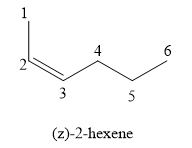
Figure 4
The parent chain contain six carbon atoms so its parent name is hex. It contains a double bond at position
The IUPAC name of
(d)
Interpretation:
The correct IUPAC name of
Concept introduction:
Alkenes are the unsaturated class of organic compounds which have a double bond in their structure. The general formula of alkene is written as
Rules for writing IUPAC name from the structural formula are given below.
• First, identify the longest carbon chain.
• The next step is to identify the groups attached to the longest chain.
• Identify the position, location, and a number of the substituents bonded to the carbon chain.
• Use prefix di, tri, tetra if the same type of substituents are present.
• Name the substituents in alphabetical order.
Answer to Problem 4.46AP
The correct IUPAC name of
Explanation of Solution
When a compound is named the first thing is to identify the longest parent chain. If the parent chain is substituted, then it is numbered in such a manner so that the substituent gets the lowest locant number. In the given case, structure and numbering is written as shown below.
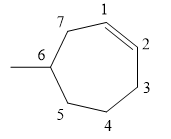
Figure 5
The method of numbering the parent chain is wrong because it is substituted by a double bond and a methyl group. It has to be numbered in such a way so that double bond and methyl group gets the lowest locant number. The lowest locant number for the double bond is
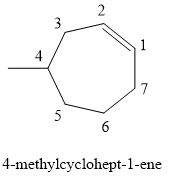
Figure 6
The structure is named as
The correct IUPAC name of
Want to see more full solutions like this?
Chapter 4 Solutions
Organic Chemistry
- V Biological Macromolecules Drawing the Haworth projection of an aldose from its Fischer projection Draw a Haworth projection of a common cyclic form of this monosaccharide: H C=O HO H HO H H OH CH₂OH Explanation Check Click and drag to start drawing a structure. Xarrow_forwardComplete the mechanismarrow_forwardComplete the mechanismarrow_forward
- 8 00 6 = 10 10 Decide whether each of the molecules in the table below is stable, in the exact form in which it is drawn, at pH = 11. If you decide at least one molecule is not stable, then redraw one of the unstable molecules in its stable form below the table. (If more than unstable, you can pick any of them to redraw.) Check OH stable HO stable Ounstable unstable O OH stable unstable OH 80 F6 F5 stable Ounstable X Save For Later Sub 2025 McGraw Hill LLC. All Rights Reserved. Terms of Use | Privacy C ཀྭ་ A F7 매 F8 F9 4 F10arrow_forwardJust try completing it and it should be straightforward according to the professor and TAs.arrow_forwardThe grading is not on correctness, so if you can just get to the correct answers without perfectionism that would be great. They care about the steps and reasoning and that you did something. I asked for an extension, but was denied the extension.arrow_forward
 ChemistryChemistryISBN:9781305957404Author:Steven S. Zumdahl, Susan A. Zumdahl, Donald J. DeCostePublisher:Cengage Learning
ChemistryChemistryISBN:9781305957404Author:Steven S. Zumdahl, Susan A. Zumdahl, Donald J. DeCostePublisher:Cengage Learning ChemistryChemistryISBN:9781259911156Author:Raymond Chang Dr., Jason Overby ProfessorPublisher:McGraw-Hill Education
ChemistryChemistryISBN:9781259911156Author:Raymond Chang Dr., Jason Overby ProfessorPublisher:McGraw-Hill Education Principles of Instrumental AnalysisChemistryISBN:9781305577213Author:Douglas A. Skoog, F. James Holler, Stanley R. CrouchPublisher:Cengage Learning
Principles of Instrumental AnalysisChemistryISBN:9781305577213Author:Douglas A. Skoog, F. James Holler, Stanley R. CrouchPublisher:Cengage Learning Organic ChemistryChemistryISBN:9780078021558Author:Janice Gorzynski Smith Dr.Publisher:McGraw-Hill Education
Organic ChemistryChemistryISBN:9780078021558Author:Janice Gorzynski Smith Dr.Publisher:McGraw-Hill Education Chemistry: Principles and ReactionsChemistryISBN:9781305079373Author:William L. Masterton, Cecile N. HurleyPublisher:Cengage Learning
Chemistry: Principles and ReactionsChemistryISBN:9781305079373Author:William L. Masterton, Cecile N. HurleyPublisher:Cengage Learning Elementary Principles of Chemical Processes, Bind...ChemistryISBN:9781118431221Author:Richard M. Felder, Ronald W. Rousseau, Lisa G. BullardPublisher:WILEY
Elementary Principles of Chemical Processes, Bind...ChemistryISBN:9781118431221Author:Richard M. Felder, Ronald W. Rousseau, Lisa G. BullardPublisher:WILEY





